

Alphabet books offer a vivid insight into the history of literacy and culture, as well as concepts of childhood. The Children's Book Collection at UCLA contains a rich array of these materials, some well-worn and much-used, some still bright and fresh. Each is a gem of print production and graphical imagery from another time and place. Though the history of alphabet books continues to the present, this exhibit focuses on the works in our collections published between 1700 and 1900, including horn books, primers, works of didacticism and seriousness, whimsy and play.
2. A Jumble ABC
3. A Little Pretty Pocket-Book
4. A New Lottery Book of Birds And Beasts
5. A Pretty Play-Thing for Children of All Denominations
8. ABC of Objects for Home And School
10. ABC with Pictures & Verses
12. Alphabet Et Instruction Pour Les Enfans
16. Dolly's ABC Book
17. Flora's ABC
18. Home ABC
22. Hornbook C. 1700
23. Large Letters for the Little Ones
24. Little ABC Book
25. Little People: An Alphabet
26. Martin's Nursery Battledoor
27. Mother Goose ABC
28. My Darling's ABC
29. Orbis Sensualium Pictus Quadrilinguis
30. People of All Nations: A Useful Toy for Girl Or Boy
31. Picture Alphabet
32. Pretty ABC
33. Railway ABC
34. Rusher's Reading Made Most Easy
38. The Alphabet of Old Friends
40. The Amusing Alphabet for Young Children Beginning To Read
42. The Child's Christian Education
45. The Easter Gift
47. The Favorite Alphabet for the Nursery
49. The Franklin Alphabet And Primer
51. The Golden ABC
55. The Moral And Entertaining Alphabet
57. The Old Testament Alphabet
59. The Picture Alphabet for Little Children
62. The Sunday ABC
63. The Union ABC
64. The Young Child's ABC, Or, First Book
65. Tom Thumb's Alphabet: Picture Baby-Books
67. Warne's Alphabet And Word Book: with Coloured Pictures
68. Wood's Royal Nursery Alphabet
Title The Military Alphabet
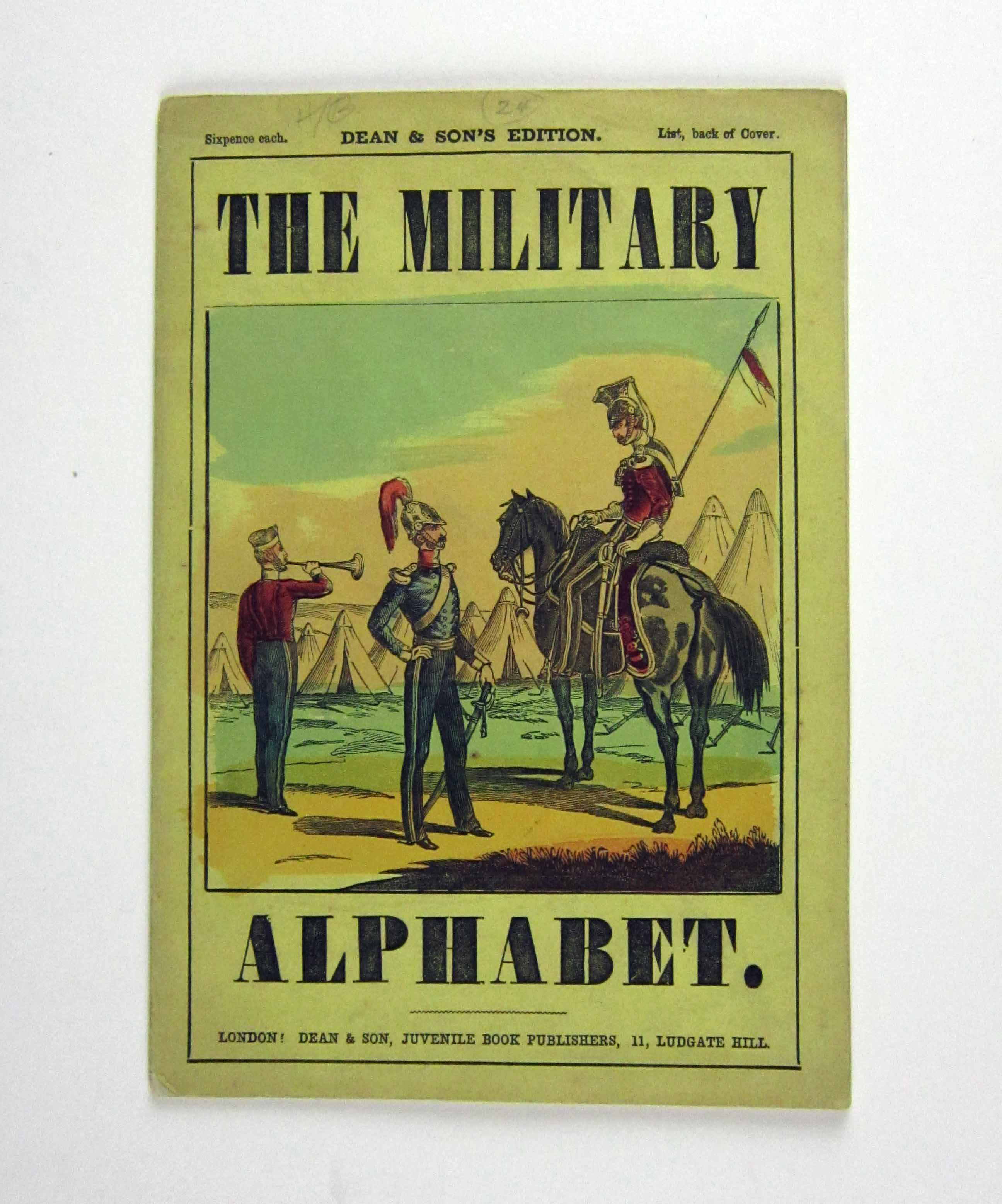
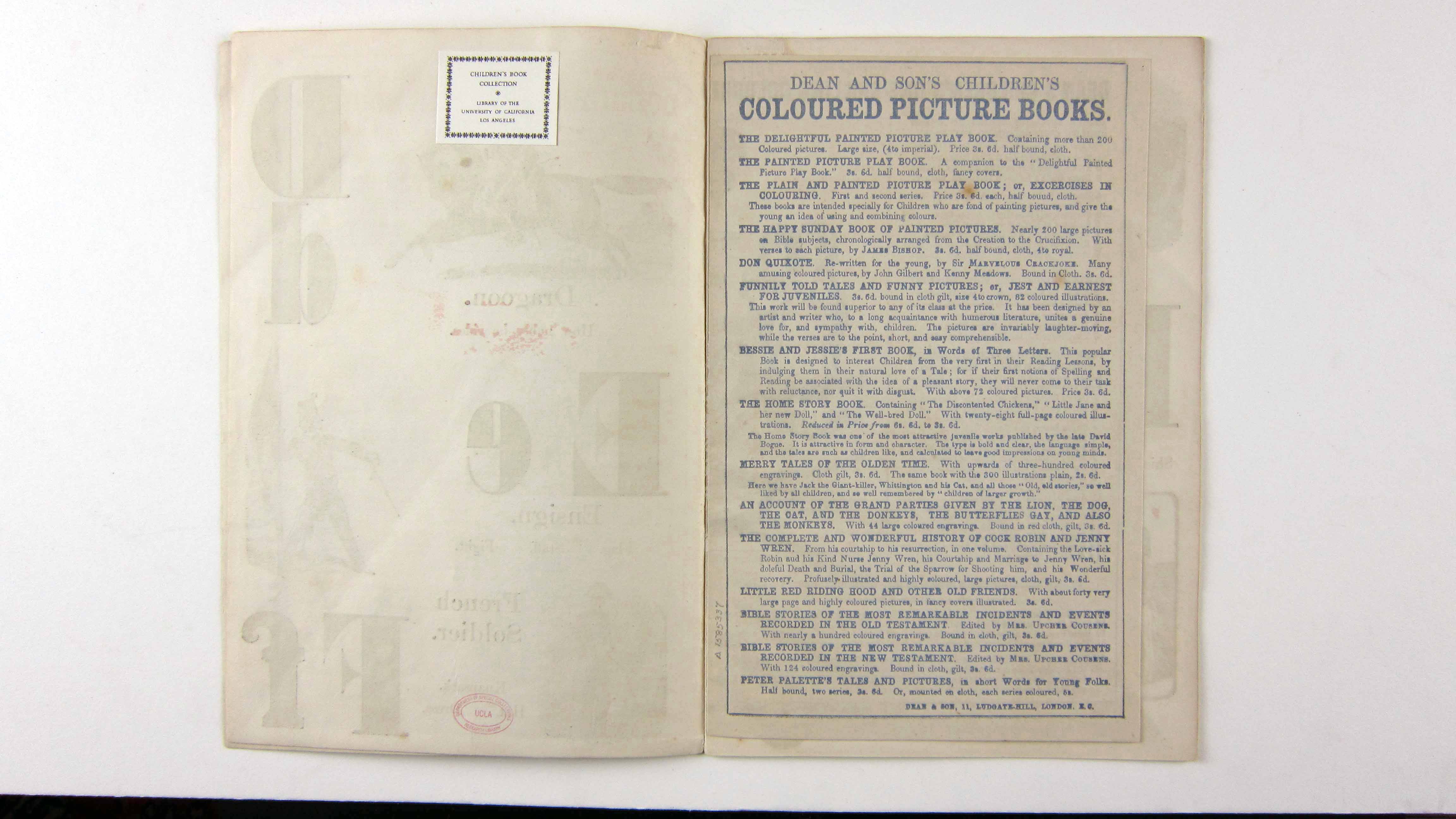
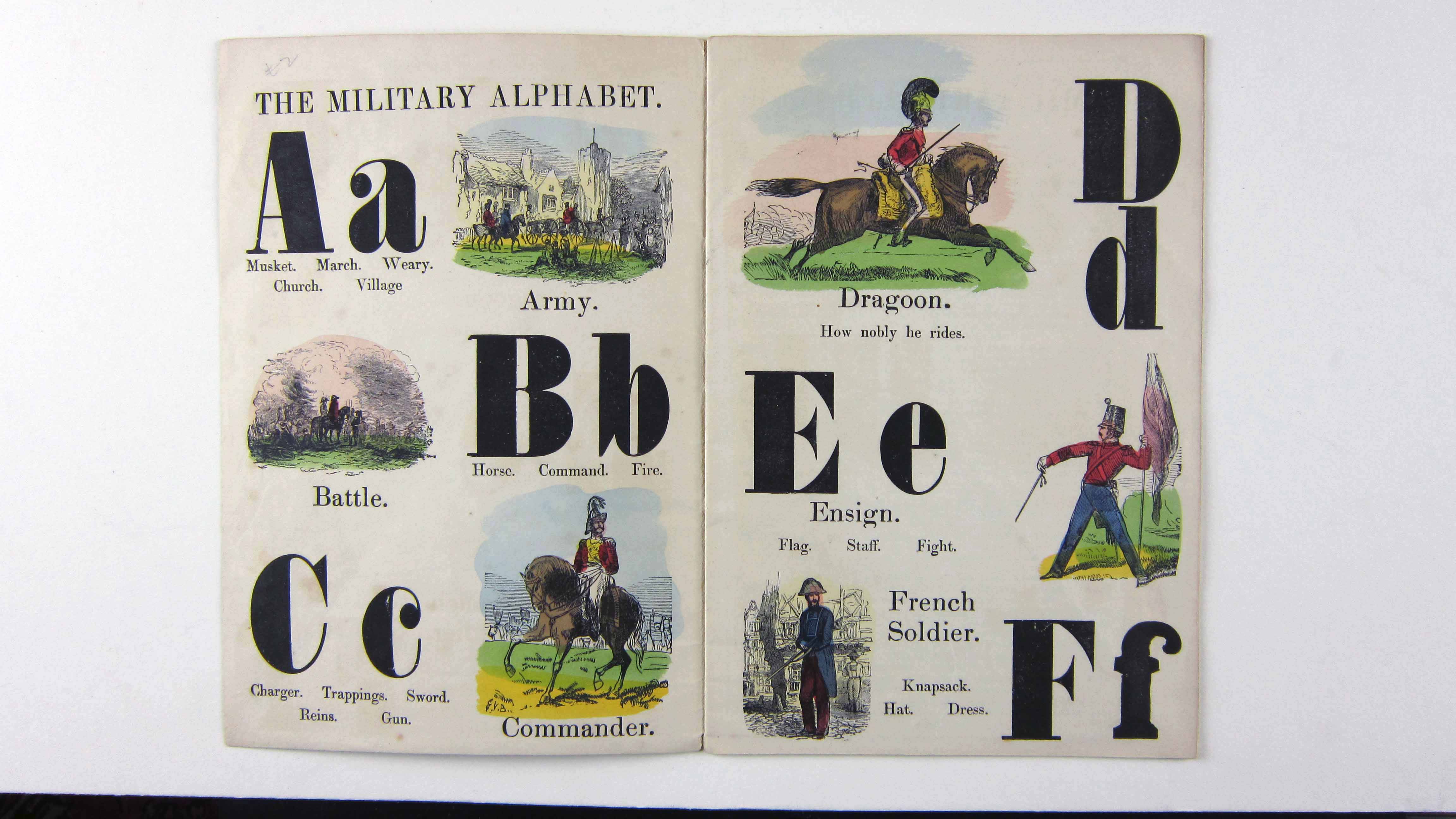
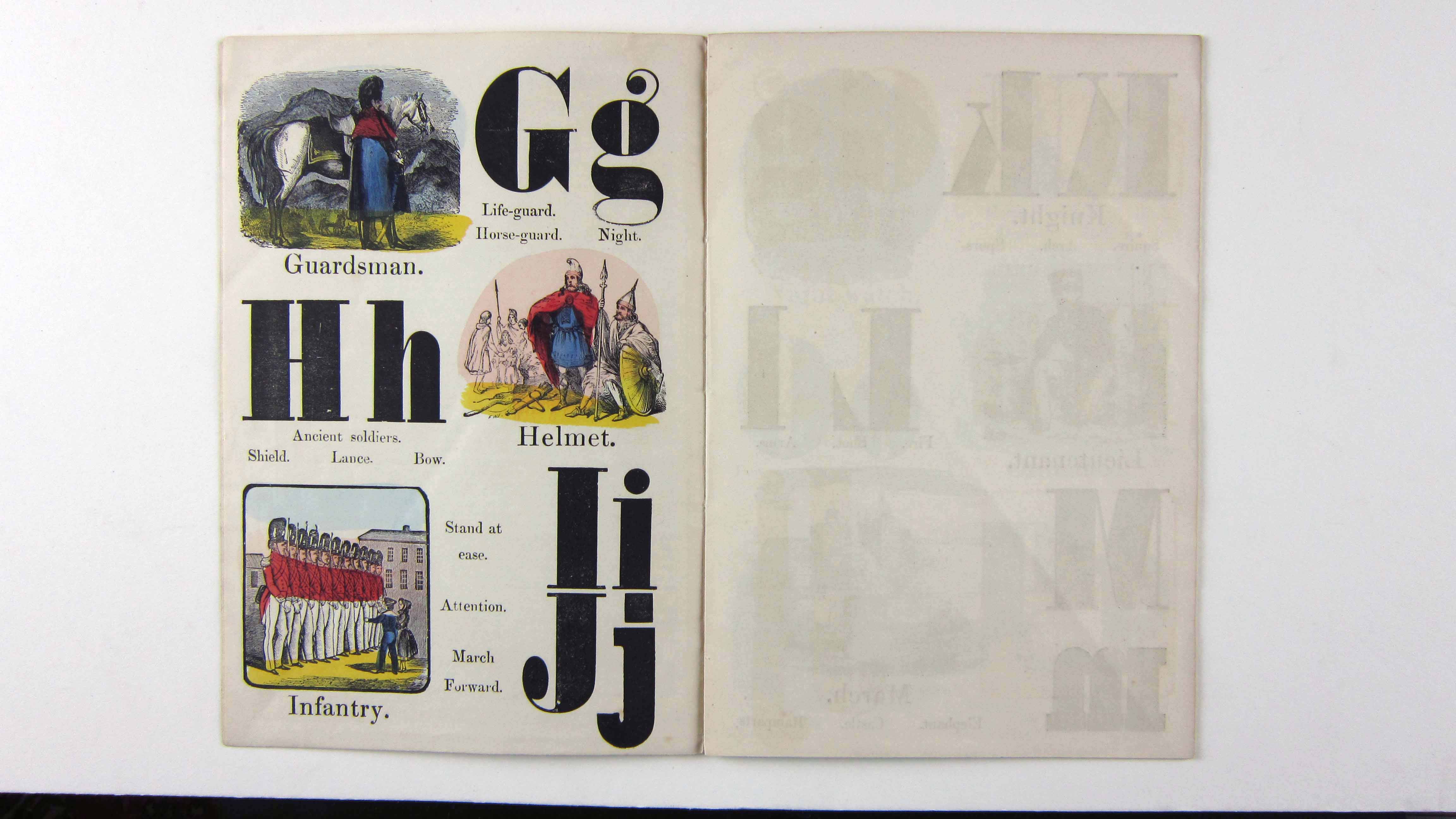
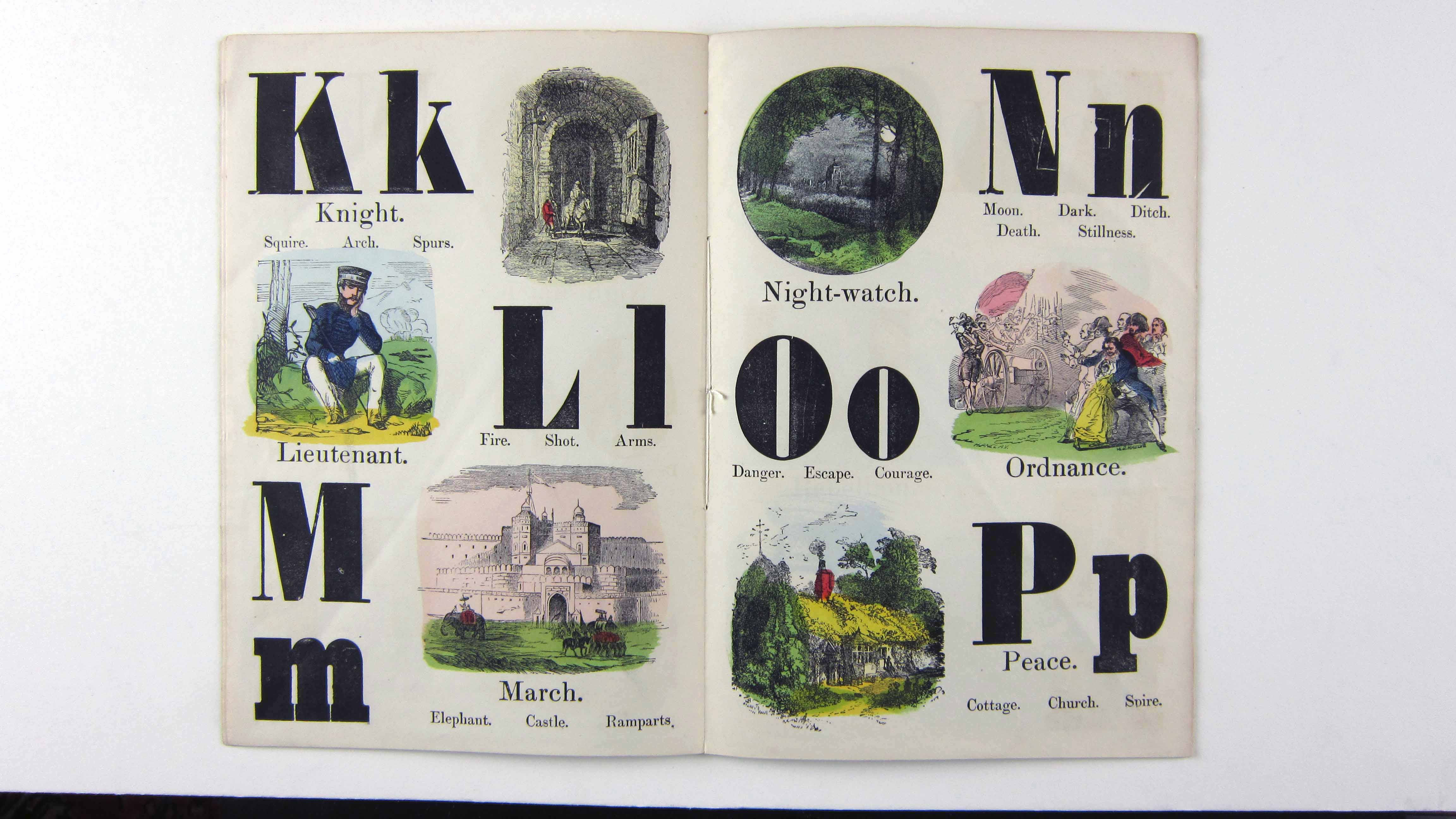


Brief description An alphabet book with vocabulary and illustrations relating to military life.
Full description The Military Alphabet is a primer published in London by Dean & Son in approximately 1862. The letters are in upper and lower case and in a large black font on smooth, durable, paper with corresponding hand-colored wood engraved illustrations for each letter. Each letter has a combination of sentences, related words, and illustrations. The covers, words, and inside illustrations all relate to the theme of a military lifestyle. A somber tone is conveyed by the realistic word choices and stark images.
Literacy Literacy was often a means to an end, especially when trying to expose young children to a specific lifestyle or goal of learning, such as religion or work skills. The Military Alphabet fits the concept that literacy can be rooted in a need to familiarize children with a way of life, such as one that revolves around military happenings. In turn, the children are given the opportunity to absorb a practical message. The overarching theme of this alphabet book encourages the teacher or family member to expose children to the harsh realities of military life at an early age. The pictures are bleak in tone and color and depict scenes related to daily tasks military men and their wives, family, and townspeople encounter. The words associated with each letter of the alphabet might plant the seed that the military life is tough, but noble and is one that a young boy will want to read more about and aspire to as he grows. Literacy is being developed through the exposure to vocabulary associated with military terms.
Childhood The Military Alphabet would have most likely been read to or by a young boy, rather than a girl in the mid 1800's. This can be assumed from both the text and pictures in the book. The starkly realistic words chosen to be associated with each letter are higher in vocabulary level, which suggests the reader is school age or being read to by a teacher or parent. Additionally, there are several words that not only do not start with the letter of the alphabet, but that also have to do with what is happening in the detailed illustrations. The images are cold and unsentimental when depicting battlefields and military life. This book can be aligned with the thinking of Joseph Zornado, who argued that children's behavior and learning is a direct result of their rearing and the way in which they interact with their parents. It would seem the child is used to a life that revolves around military activities and typical gender roles. He might even feel inspired to one day fill the role of the soldiers illustrated throughout the pages, as they are presented as heroes.
Iconography Parents setting expectations for children have always been a part of childhood and a cultural norm. The Military Alphabet aligns with this concept in a very specific way, assuming that the child would be encouraged and expected to follow the path of the people depicted throughout the pages of the book. The child engaged in this book would have been exposed to a narrow view of the world, one in which life for men, women, and children revolves around scenarios relating to the military. The child is exposed to this harsh way of life from an early age and it seems that this particular career was encouraged. Traditional gender roles are also noticeable within the pages. Women are doing the housework and shopping, while men are seen as the heroes fighting battles. For boys especially, it would seem that a military position is something to which they would want to aspire, despite the darkly realistic vocabulary choices throughout the alphabet book and the illustrations that are bleak and unapologetically matter of fact.
Production The Military Alphabet is a unique alphabet book published in London by Dean & Son, Juvenile book publishers. The publishing company was founded before the 1800's and focused on making novelty, or toy, books. During the mid 1800's the company claimed to be the firm that originated movable children's books. Due to the popularity of the movable books, Dean & Son turned all their focus on this niche department. Additionally, Thomas Dean was one of the first publishers to take advantage of lithography as a publishing technique. The starkness of the illustrations stands out to the reader when reading The Military Alphabet. Reds, grays, and blacks are the most obvious colors that are used to depict the graphic and dark nature of the images. The somber realism of a military life is expressed through terms associated with battlefields and military men.
Publisher Dean & Son Juvenile book publishers
Publication place London
Date 1862
UCLA Call Number CBC * PZ6 .M5995 1862
Repository UCLA Charles E. Young Research Library, Dept. of Special Collections
Dimensions 25 cm, height
Technologies of production Color wood engravings
Media and Materials Paper
Caption